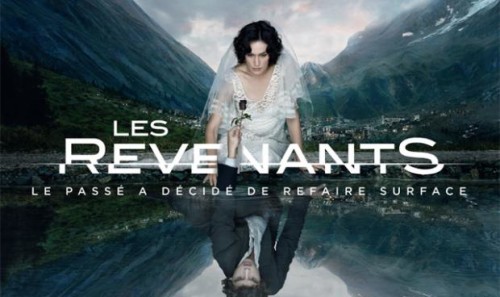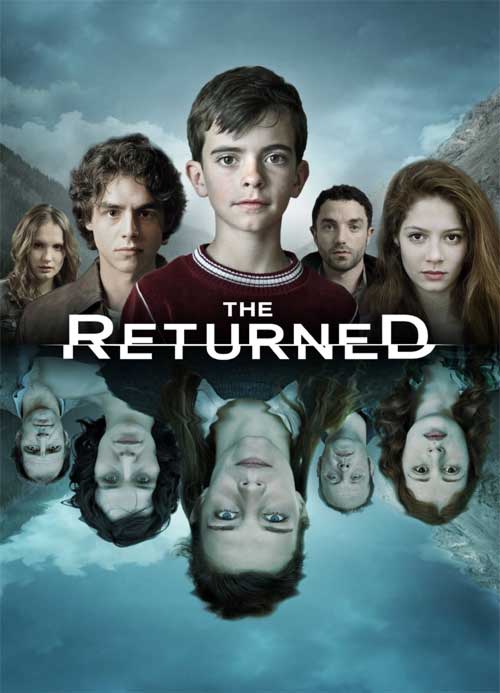This guest post by Tina Giannoulis appears as part of our theme week on The Terror of Little Girls.
The concept behind Les Revenants (or The Returned to its anglophone viewers) began in 2004, with the film of the same name. Its premise follows that of the less successful film; set in a small French village, a town reacts as its previously dead inhabitants begin to return, untouched by time or their own passing. If the show sounds familiar, you may be remembering the US series, Resurrection, based on Jason Mott’s 2013 novel, The Returned which, while sharing a title, seems to transpose the same premise to a small town in Missouri without being connected to the French works.
These permutations of the same, basic idea behind Les Revenants indicates something within it that filmmakers and writers are keen to explore. Traditional depictions of zombies are fairly straightforward affairs, using the brain-dead human to comment on all manner of social ills that spread like epidemic and manifest as thoughtless allegiance; from consumerism to organised religion, the politically unpopular to the socially demonised, zombies have acted as allegory for evils that are rendered inhuman. In recent years, the figure of the zombie has had an unmissable resurgence and has seen the figure reworked and appropriated into genres other than horror; Shaun of the Dead and Zombieland offer a comedic take on a zombie apocalypse while Warm Bodies and In The Flesh opt to re-humanise the inhuman.
Les Revenants sits somewhere between these traditional depictions and their rebirth. The series quickly shies away from the tropes of the undead but continues to play with the genres they feature in; horror and thriller elements are peppered through a thoroughly riveting drama, using the mystery and otherworldliness of the revenants to grip and frighten. With only one season aired and another in production, the easiest way to deal with unexplained facets of the story is to understand the world of Les Revenants through magical realism as, ultimately, the revenants’ origins are unnecessary when considering their roles in a series which explores so much more.
In her introduction to The Left Hand of Darkness, Ursula K. Le Guin describes science fiction as a thought-experiment, arguing that thought-experiments are not meant to predict the future but rather describe reality. It’s with this in mind that I describe Les Revenants as being a thought-experiment on loss–loss of life, time, and innocence.
The first episode opens on a 15-year-old girl, the eponymous “Camille” (Yara Pilartz), as she finds herself alone at dusk in the mountains above her town. She starts her journey back home, disoriented and a little confused but otherwise intact, despite having died in a school bus trip four years prior. She does not remember her death, nor does she notice the years that she’s missed – but her family certainly has. From mother, Claire (Anne Cosigny), to father, Jerome (Frédéric Pierrot), and twin sister, Lena (Jenna Thiem), we see a spectrum of responses to the return of something lost: joy, suspicion, refusal. While it’s undeniable that Claire and Jerome have been hugely affected by Camille’s death and return, it is Lena who provides the most interesting relationship to Camille as they navigate their mutual loss of a sister–one through death, the other through life now lived and irreversible.

As identical twins, the two have a quality as otherworldly as the revenants and a cultural history as robust as the zombie. From their bountiful presence in mythology, twins have arisen in media time and time again as two sides of the same coin, playing on opposing binaries as well as the pair’s indivisibility. Perhaps the most famous mythological twins are Castor and Pollux, who make up the constellation Gemini, with whom Camille and Lena share a history; within both sets, one twin is immortal and the other not. In both cases, this leads to a struggle as each set refuses to be split by their mortal differences. What sets them apart is that Camille and Lena have been separated once before and this was not without consequence. The gap between Camille’s death and her return leaves the twins at 15 and 19 years old and while it serves as a point of difference between the twins, it also draws them closer as two halves of the same whole; Lena reflects what Camille could have been while Camille reflects what Lena once was.

It is in the space between these two images that Les Revenants questions matters of innocence and purity. Guilt, death and virginity are embedded in their tale as Lena escapes the bus crash by playing hooky in order to have sex with her boyfriend, Frédéric, who Camille also happens to be infatuated with. This sets up a dichotomy between the sacrificial virgin and the guilty survivor which, with the action of each event being intercut, seems to play on la petit morte. More significantly, it is the first signal of Lena’s unaccompanied move through adolescence. It is here that the twins begin to move from complimentary to opposing halves; Lena is sexualised, transitioning to woman and taking on all manner of wicked vices, leaving Camille frozen in time as the incorruptible, innocent child.
A significant part of Camille’s figurative defrosting comes as she sneaks into Lena’s room. In the time since her death, Lena seems to have taken on all manner of wicked vices; Camille surveys the array of rock records, magazine cut outs, and photographs. She lingers over pictures of Frédéric and Lena smoking and smiling in a life that could just as easily have been hers. It’s a stark contrast to Camille’s shrine of a room; a few nondescript posters and girlish colours cover the walls, not to mention the no-smoking sign on her door. Smoking also plays a brief, though telling part in Camille’s characterisation – both Lena and her father have taken it up and she asks her father for a cigarette while demanding the truth on the changes that have occurred since her death. Here, Camille’s otherworldliness does not symbolise her move to adulthood but rather permits that move (or at least permits her transgressions against what is acceptable for her age).
By combining the figures of twins and zombies, Les Revenants avoids positing Camille as a figurehead for all that is good or all that is evil. Instead, she occupies a middle ground and it is this middle ground which allows the thought-experiment to run on unabated. It does not ask what if she had not died, not even what if she came back, but by making Camille a not-quite-zombie and a not-quite-twin, she becomes not-quite-Camille. Not-quite-Camille instead opens up a space to consider what has happened since her death and, through her reappearance, what loss and time have done to Lena.
It should also be noted, however, that for all Les Revenants does for acting out against conventions of little girls in horror, there is a character which rearticulates them for boys. For the most part, Victor (Swann Nambotin) is silent and unassuming, not admitting where he came from or even his real name. He is reluctantly taken in by Julie (Céline Sallette), who was once attacked by cannibal-killer, revenant, Serge (Guillaume Gouix), and soon reveals himself to be perhaps the most horrific of the revenants. Bitch Flicks’ Max Thornton wrote about the nature of violence in Les Revenants, noting the significance of Victor’s appearance in relation to Julie’s attack, stating that the series has an undercurrent of commentary on sexualised, male violence against women.
However, he mentions Victor only as plaster to this violence, a form of healing for Julie, when Victor has shown himself to be something darker. While Camille’s supernatural abilities seem to affect only her sister, Victor has the ability to cause violent visions and actions in anyone. He apparently does so to his unknowing, new-found guardian, inducing a vision of her attacker ready to repeat his crimes before the boy pries the scissors from her hands, seemingly saving her. If Serge’s attacks represent male violence at large then one could argue that Victor’s attacks represent domestic violence. More easily, the link between Victor and Serge (for Victor summons Serge’s image once more, causing Serge’s brother to shoot himself in much the way Julie was poised to impale herself), parallels the convention of a little girl being controlled by an evil spirit to embody the dangerous sexuality and power of womanhood. In Les Revenants, Victor is the little girl, Serge the evil spirit and his powers the embodiment of dangerous sexuality and violence of manhood. This reconfiguration doesn’t just even the playing field for gendered representations of children, it sheds light on far more real and dangerous evils than vampires or puberty.
Tina Giannoulis is a current media student at UNSW in Sydney, Australia. She is the convenor of UNSW Feminist Free Talks and bakes a mean red velvet cupcake. You can keep up to date with her writing and reading by following her on Twitter.









